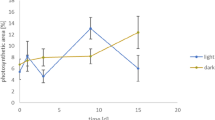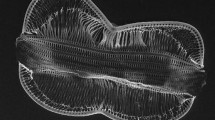Abstract
The characteristics of valine uptake by isolated microcolonies of Galaxea fascicularis (Linnaeus 1758) were studied under various conditions including light, dark and feeding. The results demonstrated the presence of: (1) a linear component which might represent either a diffusional transport or a low-affinity carrier-mediated transport (apparent carrier affinity >250 μmol·l−1), and (2) a high-affinity active carrier-mediated transport (apparent carrier affinity about 5 μmol·l-1). The latter is mediated by two different systems: (i) a Na+-dependent carrier, stimulated by light and operative in both fed and unfed polyps, and (ii) a Na+-independent carrier, light insensitive and present only in unfed polyps. Competition experiments with other amino acids show that the Na+-dependent carrier is highly specific for neutral amino acids, as indicated by the high inhibition constants of basic and acidic amino acids. Our results suggest that the energy supplied by zooxanthellae photosynthates is necessary for the process of amino acid uptake, and that the Na+-dependent carrier responsible for valine uptake by G. fascicularis is similar to the B0,+ system.
Similar content being viewed by others
Abbreviations
- AA:
-
amino acid(s)
- AC/HC:
-
ratio autotrophic/heterotrophic carbon
- ASW:
-
artificial sea water
- DOM:
-
dissolved organic material
- HPLC:
-
high performance liquid chromatography
- K 1 :
-
apparent inhibition constant
- K m :
-
apparent affinity of the carrier
- SE:
-
standard error
- V max :
-
maximal rate of absorption
References
Allemand D, De Renzis G, Ciapa B, Girard J-P, Payan P (1984) Characterization of valine transport in sea urchin eggs. Biochim Biophys Acta 722:337–346
Allemand D, De Renzis G, Maistre C, Girard J-P, Payan P (1985). Uptake of valine and alanine by a neutral amino acid carrier in sea urchin eggs: cyclic variations in the early cleavage stage. J Membr Biol 87:217–224
Babcock RC, Bull GD, Harrison PL, Heyward AJ, Oliver JK, Wallace CC, Willis BL (1986) Synchronous spawnings of 105 scleractinian coral species on the Great Barrier Reef. Mar Biol 90:379–394
Barnes DJ, Chalker BE (1990) Calcification and photosynthesis in reef-building corals and algae. In: Dubinsky Z (ed) Ecosystems of the world, coral reefs. Elsevier, Amsterdam, pp 109–131
Bhovichitra M, Swift E (1977) Light and dark uptake of nitrate and ammonium by large oceanic dinoflagellates: Pyrocystis noctiluca, Pyrocystis fusiformis, and Dissodinium lunula. Limnol Oceanogr 22:73–83
Buck M, Schlichter D (1987) Driving forces for the uphill transport of amino acids into epidermal brush border membrane vesicles of the sea anemone, Anemonia sulcata (Cnidaria, Anthozoa). Comp Biochem Physiol 88A:273–279
Budde RJA, Randall DD (1990) Light as a signal influencing the phosphorylation status of plant proteins. Plant Physiol 94:1501–1504
Bythell JC (1990) Nutrient uptake in the reef-building coral Acropora palmata at natural environmental concentrations. Mar Biol Prog Ser 68:65–69
Clausen CD, Roth AA (1975) Effect of temperature and temperature adaptation on calcification rate in the hermatypic coral Pocillopora damicornis. Mar Biol 33:93–100
Coles SL, Jokiel PL (1977) Effects of temperature on photosynthesis and respiration in hermatypic corals. Mar Biol 43:209–216
Cook CB (1972) Benefit to symbiotic zoochlorellae from feeding by green hydra. Biol Bull 142:236–247
Davis JP, Bellis S, Stephens GC (1988) Characterization of a broadscope amino acid transport system is sand dollars. Am J Physiol 254:R485-R490
D'Agostino A (1972) Antibiotics in cultures of invertebrates. In: Smith WF, Chanley MH (eds) Culture of marine invertebrate animals. Plenum Press, New York, pp 109–133
Davies PS (1991) Effect of daylight variations on the energy budgets of shallow water corals. Mar Biol 108:137–144
Domotor SL, D'Elia CF (1984) Nutrient uptake kinetics and growth of zooxanthellae maintained in laboratory culture. Mar Biol 80:93–101
Dortch Q, Maske H (1982) Dark uptake of nitrate and nitrate reductase activity of a red-tide population off Peru. Mar Biol Prog Ser 9:299–303
Douglas AE, Smith DC (1983) The cost of symbionts to their host in green hydra. In: Schenk HEA, Schwemmler W (eds) Endocytobiology II. W de Gruyter & Co., New York, pp 631–648
Fadlallah YH, Lindo RT (1988) Contrasting cycles of reproduction in Stylophora pistillata from the Red Sea and the Arabian Gulf, with emphasis on temperature. Proc 6th Int Coral Reef Symp 3:225–230
Falkowski PG, Stone DP (1975) Nitrate uptake in marine phytoplankton: energy sources and the interaction with carbon fixation. Mar Biol 32:77–84
Falkowski PG, Jokiel PL, Kinzie III RA (1990) Irradiance and corals. In: Dubinsky Z (ed) Ecosystems of the world 25, coral reefs. Elsevier, Amsterdam, pp 89–107
Ferrier MD (1991) Net uptake of dissolved free amino acids by four scleractinian corals. Coral Reefs 10:183–187
Fitt WK, Pardy RL (1981) Effects of starvation, and light and dark on ther energy metabolism of symbiotic and aposymbiotic sea anemones, Anthopleura elegantissima. Mar Biol 61:199–205
Gache C, Vacquier VD (1983) Transport of methionine in sea-urchin sperm by a neutral amino-acid carrier. Eur J Biochem 133:341–347
Guidotti GG, Borghetti AF, Gazzola GC (1978) The regulation of amino acid transport in animal cells. Biochim Biophys Acta 515:329–366
Ip YK, Lim LL, Lim RWL (1991) Some properties of calcium-activated adenosine triphosphate from the hermatypic coral Galaxea fascicularis. Mar Biol 111:191–197
Ikeda T (1977) The effect of laboratory conditions on the extrapolation of experimental measurements to the ecology of marine zooplankton. IV. Changes in respiration and excretion rates of boreal zooplankton species maintained under fed and starved conditions. Mar Biol 41:241–252
Jaubert J (1989) An integrated nitrifying-denitrifying biological system capable of purifying sea water in a closed circuit aquarium. In: Maigret J, Toulemont A (eds), Deuxième Congrès International d'Aquariologie (1988) Monaco. Bull Inst Océanogr, no spécial 5:101–106
Kremer P (1982) Effect of food availability on the metabolism of the ctenophore Mnemiopsis mccradyi. Mar Biol 71:149–156
Lee C, Bada JL (1977) Dissolved amino acids in the equatorial Pacific, the Sargasso Sea, and Biscayne Bay. Limnol Oceanogr 22:502–510
Léger P, Bengston DA, Simpson KL, Sorgeloons P (1986) The use and nutritional value of Artemia as a food source. Oceanogr Mar Biol Annu Rev 24:521–623
Lindstedt KJ, Muscatine L, Lenhoff HM (1968) Valine activation of feeding in the sea anemone, Boloceroides. Comp Biochem Physiol 26:567–572
Mayer AG (1916) Lower temperatures at which reef corals lose their ability to capture food. Carnegie Inst Wash Yearbook 14:212
McDermott AM, Blanquet RS (1991) Glucose and glycerol uptake by isolated zooxanthellae from Cassiopea xamachana: transport mechanisms and regulation by homogenate fractions. Mar Biol 108:129–136
Muscatine L (1990) The role of symbiotic algae in carbon and energy flux in reef corals. In: Dubinsky Z (ed) Ecosystems of the world, coral reefs. Elsevier, Amsterdam pp 75–87
North BB, Stephens GC (1971) Uptake and assimilation of amino acids by Platymonas. II. Increased uptake in nitrogen-deficient cells. Biol Bull 140:242–254
O'Dell SJ, Stephens GC (1986) Uptake of amino acids by Pareurythoe californica: substrate interaction modifies net influx from the environment. Biol Bull 171:682–693
Oxender DL, Christensen HN (1963) Distinct mediating systems for the transport of neutral amino acids by the Ehrlich cells. J Biol Chem 238:3686–3699
Paasche E, Bryceson I, Tangen K (1984) Interspecific variation in dark nitrogen uptake by dinoflagellates. J Phycol 20:394–401
Preston RL (1987) d-Alanine transport and metabolism by coelomocytes of the bloodworm, Glycera dibranchiata (Polychaeta). Comp Biochem Physiol 87B:63–71
Preston RL (1990) Sodium amino acid contransport systems in marine invertebrates. In: Kinne RKH (ed) Comparative aspects of sodium cotransport systems. Comparative physiology, vol 7, Karger Basel, pp 1–129
Preston RL, Stevens BR (1982) Kinetic and thermodynamic aspects of sodium-coupled amino acid transport by marine invertebrates. Am Zool 22:709–721
Schiller C, Herndl GJ (1989) Evidence of enhanced microbial activity in the interstitial space of branched corals: possible implications for coral metabolism. Coral reefs 7:179–184
Schlichter D (1978) On the ability of Anemonia sulcata (Coelenterata: Anthozoa) to absorb charged and neutral amino acids simultaneously. Mar Biol 45:97–104
Schlichter D (1980) Adaptation of cnidarians for integumentary absorption of dissolved organic material. Rev Can Biol 39:259–282
Schlichter D (1982a) Nutritional strategies of the alcyonarian Heteroxenia fuscescens (Ehrb.): absorption of dissolved organic material and lost endogenous photosynthates. Oecologia 53:40–49
Schlichter D (1982) Epidermal nutrition of the absorption, translocation and utilization of dissolved nutrients by Heteroxenia fuscescens. Am Zool 22:659–669
Schlichter D (1984) Cnidaria: permeability, epidermal transport and related phenomena. In: Bereiter-Hahn J et al. (eds) Biology of the integument, vol 1. Invertebrates. Springer, Berlin, pp 79–95
Schlichter D, Liebezeit G (1991) The natural release of amino acids from the symbiotic coral Heteroxenia fuscescens (Ehrb.) as a function of photosynthesis. J Exp Mar Biol Ecol 150:83–90
Schlichter D, Bajorat KH, Eckess P, Gutknecht D, Kraus P, Krish H, Schmitz B (1986) Epidermal nutrition of sea anemones by absorption of organic compounds dissolved in the oceans. Zool Beitr N F 30:29–47
Sebens KP (1977) Autotrophic and heterotrophic nutrition of coral reef zoanthids. Proc 3rd Int Coral Reef Symp 1:397–404
Shotwell MA, Kilberg MS, Oxender DL (1983) The regulation of neutral amino acid transport in mammalian cells. Biochim Biophys Acta 737:267–284
Steen RG (1986) Evidence for heterotrophy by zooxanthellae in symbiosis with Apiptasia pulchella. Biol Bull 170:267–278
Stephens GC (1962) Uptake of organic material by aquatic invertebrates. I. Uptake of glucose by the solitary coral, Fungia scutaria. Biol Bull 123:648–659
Stephens GC (1988) Epidermal amino acid transport in marine invertebrates. Biochim Biophys Acta 947:113–138
Stephens GC, Schinske RA (1961) Uptake of amino acids by marine invertebrates. Limnol Oceanogr 6:175–181
Stoscheck CM (1990) Quantitation of protein. In: Deutscher MP (ed) Methods in enzymology, vol 182. Guide to protein purification. Academic Press, New York, pp 50–68
Syrett PJ (1981) Nitrogen metabolism of microalgae. In: Platt T (ed) Physiological bases of phytoplankton ecology. Can Bull Fish Aquat Sci 210:182–210
Szmant-Froelich A, Pilson MEQ (1980) The effects of feeding frequency and symbiosis with zooxanthellae on the biochemical composition of Astrangia danae Milne Edwards and Haime. J Mar Biol Ecol 48:85–97
Tiffon Y (1975) Hydrolases dans l'ectoderme de Cerianthus lloydi Gosse, Cerianthus membranaceus Spallanzani et Metridium senile (L): mise en evidence d'une digestion extracellulaire et extracorporelle. J Exp Mar Biol Ecol 18:243–254
Van Winkle LJ, Christensen HN, Campione AL (1985) Na+-dependent transport of basic, zwitterionic, and bicyclic amino acids by a broad-scope system in mouse blastocysts. J Biol Chem 260:12118–12123
Wilkerson FP, Muscatine L (1984) Uptake and assimilation of dissolved inorganic nitrogen by symbiotic sea anemone. Proc R Soc Lond Ser B 221:71–86
Wilkinson CR (1986) The nutritional spectrum of coral reef benthos. Oceanus 29:68–75
Wright SH (1985) Multiple pathways for amino acid transport in Mytilus gill. J Comp Physiol B 156:259–267
Wright SH, Manahan DT (1989) Integumental nutrient uptake by aquatic organisms. Annu Rev Physiol 51:585–600
Wright SH, Stephens GC (1977) Characteristics of influx and net flux of amino acids in Mytilus californianus. Biol Bull 152:295–310
Author information
Authors and Affiliations
Rights and permissions
About this article
Cite this article
Al-Moghrabi, S., Allemand, D. & Jaubert, J. Valine uptake by the scleractinian coral Galaxea fascicularis: characterization and effect of light and nutritional status. J Comp Physiol B 163, 355–362 (1993). https://doi.org/10.1007/BF00265638
Accepted:
Issue Date:
DOI: https://doi.org/10.1007/BF00265638




